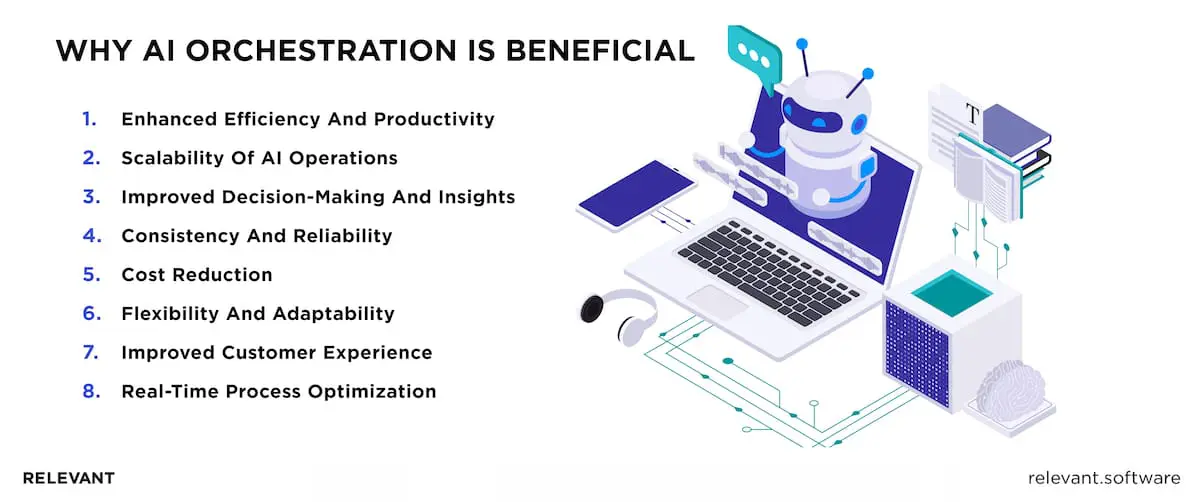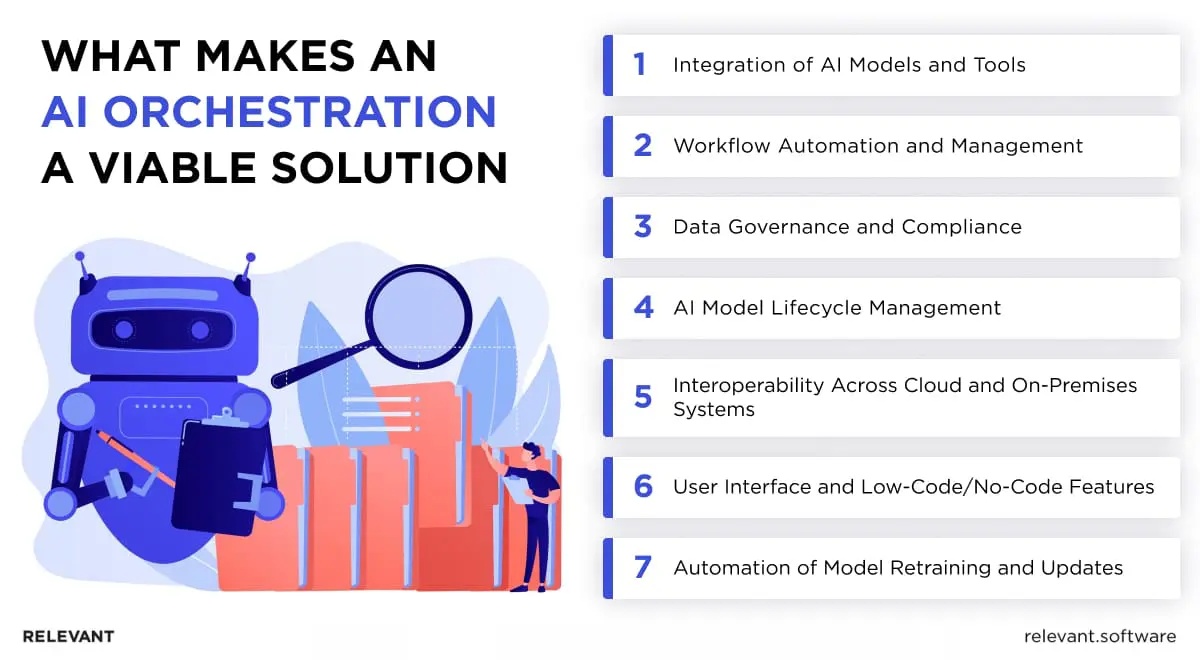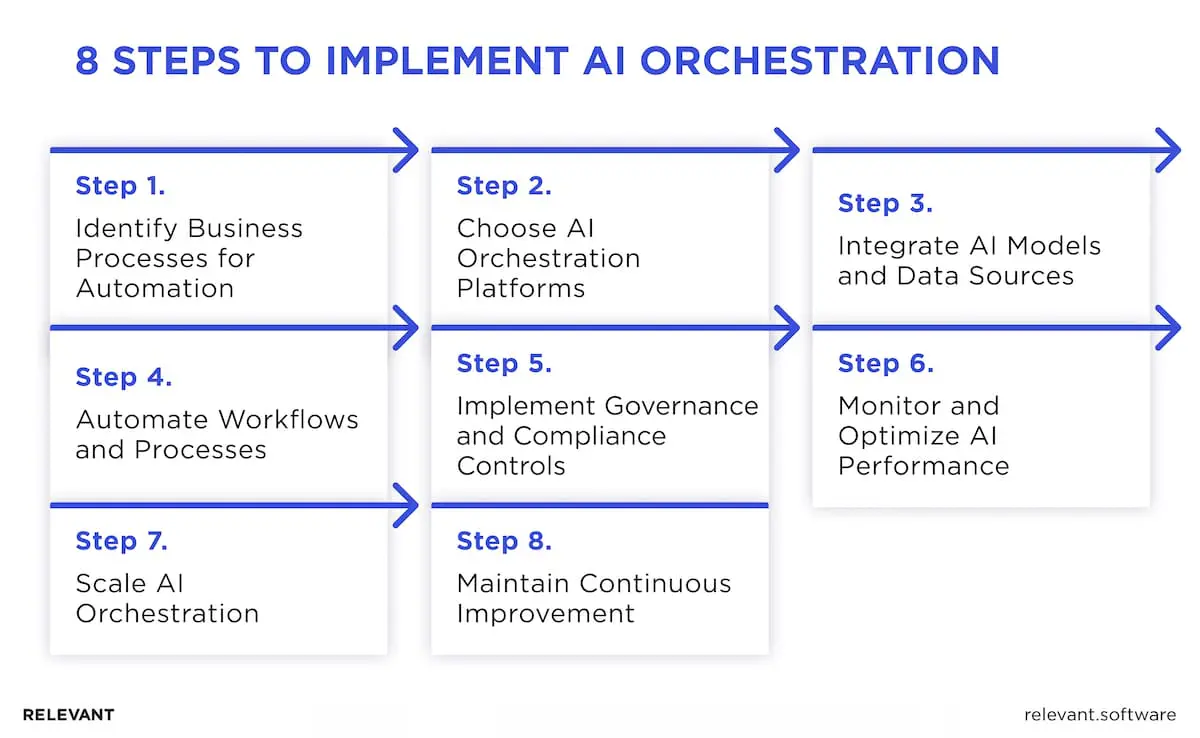AI Orchestration: The Key to Scaling Intelligent Automation

If you’ve been building up a stack of AI solutions that don’t quite play nicely together, you’re not alone. Many teams in fintech and beyond have implemented powerful tools that don’t reach their full potential because they’re, well… disorganized. AI orchestration can bring so much-needed harmony to your AI ecosystem.
AI development services are in high demand at the moment, but when your AI tools operate in silos, you’re unlikely to get the results you may expect from AI systems. According to Gartner, just 54% of AI projects actually made it to production. AI orchestration is on the lips of every tech leader, but what does it actually mean for your business? And most importantly, how can it help you scale intelligent automation to make a real impact? These are good questions many decision-makers ask themselves. If you’re curious about the business benefits of AI orchestration, you’re in the right place.
What is AI Orchestration?
Getting AI tools to work together can sometimes feel like organizing a team where everyone speaks a different language. One tool tracks customer data, another handles automation, and yet another crunches predictive models. Each tool is beneficial alone, but without some coordination, they often fall short of achieving the bigger goals businesses expect. That’s when you need AI orchestration.
Definition of AI Orchestration
Let’s clarify what AI orchestration is and why it’s so important for businesses striving to scale intelligent automation.
AI orchestration is the process of automating, managing, and coordinating multiple AI models, tools, and workflows so they flow seamlessly as part of a larger, interconnected system. It helps each component of your ecosystem (databases, different types of AI models, algorithms, etc.) cooperate to complete complex tasks.
For example, in financial services, where vast amounts of data need to move seamlessly between risk assessment models and transaction monitoring algorithms, AI orchestration ensures that data ingestion, processing, analysis, and reporting all work in sync. It synchronizes data flow across databases, triggers automated responses, and manages resource allocation across the system. So, when new data enters, it can be automatically processed by the right models, routed to the necessary algorithms, and updated across all relevant databases. In terms of business benefits, think about fast, accurate decisions that are so critical in high-stakes environments.
| Key Characteristics | Singular AI Applications | Multiple AI Applications with AI Orchestration |
| Functionality | Performs isolated tasks efficiently | Coordinates tasks across multiple AI models for end-to-end solutions |
| Data Flow | Limited data sources; data flows within one model | Integrates data from multiple sources for comprehensive insights |
| Flexibility | Limited flexibility; adjustments affect only one model | High flexibility; models and workflows can be adjusted seamlessly |
| Scalability | Scaling is limited to a single application | Scales across multiple applications, enabling growth in complex environments |
| Efficiency | Effective within its specific task, but lacks broader impact | Increases efficiency across workflows, reducing redundancy |
| Automation | Automates a single process or task | Automates entire workflows with interconnected steps |
| Decision-Making Capabilities | Provides insights within a narrow scope | Delivers holistic insights, leveraging multiple models and data points |
| Error Handling | Errors impact only the specific model | Manages errors system-wide, rerouting tasks to minimize disruption |
| Adaptability to New Data | Requires manual retraining for model updates | Automatic retraining and updates across models with new data inputs |
| User Experience | May require manual coordination with other applications | Provides a seamless experience with consistent, integrated outputs |
| Compliance and Security | Focused on single-model security | Orchestrates compliance and security across entire workflows, ensuring data integrity |
| Resource Utilization | Limited optimization of resources | Optimizes resource allocation across multiple AI models |
How AI Orchestration Differs from Automation
Automation usually aims to speed up individual tasks. Orchestration, on the other hand, manages how these tasks come together as a whole. It’s the difference between quickly completing a single task and ensuring all your AI tools function cohesively. AI orchestration helps each model and tool “talk” to the others, creating a system that can adapt and respond to changes while keeping everything on track.
Why AI Orchestration is Critical for Scaling Intelligent Automation
In an ideal world, AI would scale up as effortlessly as we add new tools. But the reality? AI ecosystems quickly grow complex, with multiple workflows and data sources often working in isolation. For any organization serious about scaling its intelligent automation, AI orchestration is the key to success.
The Need for Scalable AI Solutions
As companies accelerate AI implementation at a larger scale, it’s not uncommon for them to encounter a tangled web of challenges—coping with a number of AI models, handling increasing data streams, managing separate workflows, and similar. Without orchestration, this complexity slows everything down, introduces bottlenecks, and makes it nearly impossible to achieve consistent results. AI orchestration tools help cut through this chaos and scale AI solutions with ease, no matter how complex the environment becomes. If you’re interested, you can learn more about the role of AI in software development.
Benefits of AI Orchestration
With AI orchestration, you can design each step of your workflow to match your business needs and automate the entire process from start to finish. Due to this, the integration of AI or language models directly into your current workflows becomes much easier. Simply put, an AI orchestrator lets businesses use AI, avoiding its operational complexities. Yet, what other advantages can companies expect to gain from it?

- Enhanced Efficiency and Productivity
An AI orchestration platform takes the hassle out of coordinating AI services and workflows. Instead of spending hours syncing up different tools, your team can focus on big-picture goals while orchestration handles the rest.
- Scalability of AI Operations
With AI orchestration, scaling up is no longer a daunting task. Adding new models or data sources happens without the typical bottlenecks, which lets your AI initiatives grow right alongside your business.
- Improved Decision-Making and Insights
When your AI tools are all in sync, the insights you get are richer and more comprehensive. Thanks to AI orchestration, the data from different sources merges seamlessly, giving you accurate, big-picture insights for faster decision-making.
- Consistency and Reliability
Orchestrated AI operations bring a level of predictability that’s hard to achieve with standalone tools. That’s why you can be sure that workflows perform predictably and deliver consistent results, even as operations scale.
- Cost Reduction
One more pleasant benefit of generative AI orchestration is lower costs. How? Better coordination of workflows allows companies to get rid of redundant processes and decrease operational costs, which makes AI investments more financially attractive in the long run.
- Flexibility and Adaptability
When you use AI orchestration, adapting to change becomes easier and less painful. You can tweak processes, shift priorities, or adjust workflows on the spot without disrupting the entire system. The ability to respond quickly in a fast-moving market is an undeniable advantage today.
- Improved Customer Experience
AI orchestration doesn’t just benefit your team—it directly impacts customers. Faster responses, personalized recommendations, and smoother service are all possible when AI processes operate in unison.
- Real-Time Process Optimization
Orchestration empowers systems to self-optimize in real-time. By reallocating resources and adjusting tasks as needed, AI orchestration prevents slowdowns and keeps everything running at peak performance, ready to adapt at a moment’s notice.
Key Components of AI Orchestration
AI orchestration may sound complex, but in reality, it’s simply the connective tissue between your numerous AI system’s elements that help them work together smoothly. Let’s dig a bit deeper to understand what makes AI orchestration so impactful for modern businesses.

Integration of AI Models and Tools
AI orchestration tools bring together various AI models—like machine learning, NLP, and computer vision—and ensure they work together. They keep data moving between tools so that each model gets the information it needs exactly when it needs it. This makes adding new models or tools far less of a hassle and helps the entire system work in sync effortlessly.
Workflow Automation and Management
Complex workflows, which are common in large enterprises, require a lot of coordination and management. AI workflow orchestration helps with that as it takes care of sequencing tasks, recovering from errors, keeping data consistent across systems, and more. If we compare it to a relay race, orchestration makes sure each “runner” knows their role, passes the baton on time, and keeps the entire process moving smoothly, even when there’s an unexpected hurdle.
Data Governance and Compliance
In industries like finance or insurance, data security and compliance are more than just formalities. Adherence to rules is a must, yet it’s quite difficult without certain safeguards and tools. From this perspective, AI orchestration is a big facilitator since it establishes clear protocols for data handling that help you ensure sensitive information is managed properly and regulatory standards are met. Thanks to it, you can more confidently manage complex data flows and avoid non-compliance issues.
AI Model Lifecycle Management
Managing an AI model is not a “set it and forget it” deal. It’s rather a living system that you need to nurture so it evolves and improves over time, especially given the growing impact of AI on software development. AI orchestration platforms take charge of a model’s entire journey, starting from the initial deployment to ongoing monitoring, retraining, and version control.
They track each model’s performance, flagging any drift in accuracy or relevance, and then initiate retraining as needed so the model stays current and continues to deliver accurate results. When updates or tweaks are required, the platform handles it all automatically, so everything stays well-organized while the risk of errors that come with manual oversight is cut to a minimum.
Interoperability Across Cloud and On-Premises Systems
AI often operates in a mix of environments—some in the cloud, some on local servers, and probably some out on edge devices. AI orchestration platforms make it possible for all these systems to work together without a hitch. They create secure pathways for data to flow between cloud apps and local servers, so no matter where the data is stored, it’s always accessible and consistent.
Orchestration also deals with tricky compatibility issues (standardizing data formats and synchronization) so all parts of the system communicate flawlessly. So, with orchestration, your company can freely use cloud and on-premise infrastructures for AI tools without worrying about integration headaches or data silos holding you back.
User Interface and Low-Code/No-Code Features
Let’s face it: not everyone working with AI is a programmer. That’s why, to simplify the AI development process and help non-technical users design workflows, modern AI orchestration tools offer easy-to-use interfaces with low-code or no-code options. The drag-and-drop functionality lets anyone with little technical experience build automated processes and manage workflows without the need for specialized knowledge. With AI capabilities accessible to teams across departments, you can speed up projects and reduce the load on IT.
Automation of Model Retraining and Updates
AI models can quickly lose their edge if they’re not retrained with fresh data. AI orchestration platforms automate this retraining process, kicking off updates as soon as new data is available. No more human intervention is required to update the models. It’s like a built-in maintenance crew for your AI that supports it in top shape without extra effort.
AI Orchestration Use Cases in Financial Services
The financial industry is probably one of the leading sectors in terms of investments in AI-driven fintech software development services. There’s nothing to be surprised about because financial institutions deal with huge amounts of data, complex regulations, and urgently required tools and system remodeling to be able to respond to modern requirements. Yet, the management complexity of a number of AI tools called for new solutions – AI orchestration. And here are some ways it helps financial companies.
Fraud Detection and Prevention
Fraud can happen in the blink of an eye, and spotting it needs to happen even faster or better before it even happens. With AI orchestration, financial institutions can consolidate several AI models to work in sync and catch suspicious transactions right as they happen. Instead of relying on one tool, orchestration lets banks connect multiple models to monitor for risky patterns, strange behaviors, and red flags—all in real-time.
Customer Service Automation
Nobody likes to talk to a chatbot that gives primitive, robotic, and sometimes irrelevant answers, especially when it concerns financial matters. AI orchestration is one of the efficient ways to make customer service feel a lot more personal. By connecting chatbots and virtual assistants directly to account data and backend systems, they gain the ability to respond with relevant, personalized info in an instant. Now, they can actually address clients’ unique needs—whether it’s checking a balance, explaining a transaction, or helping with a loan inquiry.
Risk Management and Compliance
Complying with KYC and AML is crucial in finance, but it’s no small task because of the complexity and constant updates in regulatory requirements. AI orchestration makes this whole process a lot easier by automating data verification, identity checks, and all other tedious tasks. Instead of manual back-and-forths and endless data cross-checks, orchestration connects every necessary data source and compliance step into a streamlined workflow. So, rather than drowning in paperwork, teams can handle regulatory demands with fewer hiccups and way more accuracy.
8 Steps to Implement AI Orchestration Successfully
We can’t say that AI orchestration implementation is difficult. The key is to approach it strategically and not try to do everything at once but break down the process into manageable steps to ensure each piece fits seamlessly into your operations. As for the steps, we have outlined them for you to follow or adapt to your needs.

1. Identify Business Processes for Automation
Start by pinpointing processes where automation can make the most impact. First of all, look for those repetitive, time-consuming tasks that keep popping up. Which of them slows things down or keeps your team from working on bigger goals? Once you find these spots, it will be clearer where AI can bring a bit more ease and efficiency to everyone’s day.
2. Assess and Choose AI Orchestration Platforms
Picking the right platform matters because not every option will work for you. Search for options and evaluate them based on your needs, budget, and tech stack compatibility. A good platform should offer intuitive workflow automation, seamless integration capabilities, and strong support for your chosen AI models. When the platform feels like a natural fit, it’ll be a lot easier to make AI truly work for your team.
3. Integrate AI Models and Data Sources
Now that you’ve selected a platform, it’s time to integrate your AI models (machine learning, natural language processing, and computer vision) and relevant data sources into the orchestration platform. This means setting up secure data pipelines and configuring data preprocessing steps to keep the input consistent and clean. Data validation checks and regular model performance monitoring will also help you make sure that the models give you real, useful insights.
4. Automate Workflows and Processes
Here’s where you get to put automation to work! Map out the processes you’ve chosen (it could be simple data tasks or multi-step decision-making) and let AI take over the repetitive workflows that eat your valuable time. Just remember to keep things flexible—you’ll want to tweak the setup in the future as real-life needs change.
5. Implement Governance and Compliance Controls
Governance sounds formal, but it’s just about making sure everything stays ethical, secure, and compliant. Set up clear guidelines and implement security measures (data access controls, audit trails, monitoring mechanisms, etc.) so your AI actions follow regulations like GDPR and internal policies. With these controls in place, you can trust your system is doing things the right way without any last-minute surprises.
6. Monitor and Optimize AI Performance
For good or for bad, AI is kind of a solution that constantly needs an overview and updates after the implementation. Regularly monitor how well your AI models perform and make corresponding tweaks to optimize efficiency and accuracy. We also recommend you track metrics like speed, accuracy, and outcomes to stay in control of your AI operations.
7. Scale and Expand AI Orchestration
As your AI orchestration strategy proves effective, look for new areas to scale. Expand automation into other processes or departments that could benefit from it. Just scale mindfully—ensure the infrastructure can handle increased complexity and data flow.
8. Maintain Continuous Improvement
Keep your AI orchestration sharp by embracing continuous improvement. Regularly review performance, update models, and refine workflows to stay responsive to changes in technology, business goals, and compliance standards.
How Relevant Can Help You with AI Orchestration
In a world that’s changing faster than you can say “AI,” using AI orchestration isn’t just a good idea—it’s becoming essential for businesses to thrive. As a forward-looking business leader, you can take the pressure off your team through AI orchestration that automates repetitive tasks and makes sure your AI models stay sharp and accurate. If scaling AI without the usual headaches sounds like what you need, orchestration might be your new best friend.
You can do it in-house, but more often than not, companies don’t have relevant IT professionals to handle it from start to finish without a hitch. That’s one of the main reasons behind such a spike in AI outsourcing, along with cost efficiency and lower risks. If you’re one of those companies that seek a reliable tech partner for your AI orchestration needs, cooperation with Relevant might be your best decision. Recognized as a leader in AI services by one of the most reputable platforms, Clutch, you can be sure your AI project is in expert hands with Relevant.

As a software development company, we can help you with everything related to AI and development, including the coordination of your AI tools. Our AI experts with experience with hands-on experience in model integration and workflow automation, can:
- Ensure smooth integration of AI models across your systems
- Optimize workflows to enhance productivity and reduce bottlenecks
- Maintain and monitor model performance to keep results accurate and up-to-date
- Implement compliance and security measures for data protection
We don’t believe in one-size-fits-all solutions; we tailor each AI orchestration strategy to fit your unique goals, so your AI is truly working for you. If that’s what you seek, contact us to discuss your needs.



